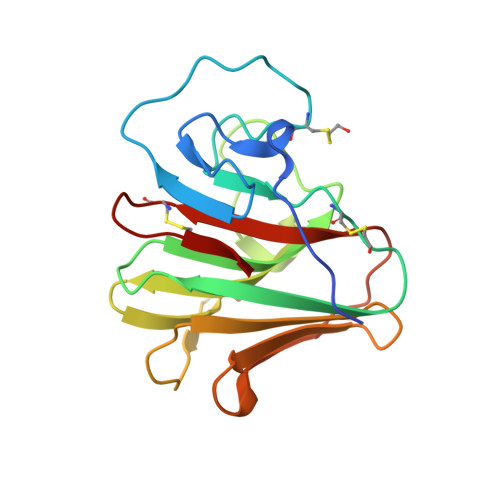Crystal structure and mutational analysis of the human TRIM7 B30.2 domain provide insights into the molecular basis of its binding to glycogenin-1.
Munoz Sosa, C.J., Issoglio, F.M., Carrizo, M.E.(2021) J Biol Chem 296: 100772-100772
- PubMed: 33989636
- DOI: https://doi.org/10.1016/j.jbc.2021.100772
- Primary Citation of Related Structures:
6UMA, 6UMB - PubMed Abstract:
Tripartite motif (TRIM)7 is an E3 ubiquitin ligase that was first identified through its interaction with glycogenin-1 (GN1), the autoglucosyltransferase that initiates glycogen biosynthesis. A growing body of evidence indicates that TRIM7 plays an important role in cancer development, viral pathogenesis, and atherosclerosis and, thus, represents a potential therapeutic target. TRIM family proteins share a multidomain architecture with a conserved N-terminal TRIM and a variable C-terminal domain. Human TRIM7 contains the canonical TRIM motif and a B30.2 domain at the C terminus. To contribute to the understanding of the mechanism of action of TRIM7, we solved the X-ray crystal structure of its B30.2 domain (TRIM7 B30.2 ) in two crystal forms at resolutions of 1.6 Å and 1.8 Å. TRIM7 B30.2 exhibits the typical B30.2 domain fold, consisting of two antiparallel β-sheets of seven and six strands, arranged as a distorted β-sandwich. Furthermore, two long loops partially cover the concave face of the β-sandwich defined by the β-sheet of six strands, thus forming a positively charged cavity. We used sequence conservation and mutational analyses to provide evidence of a putative binding interface for GN1. These studies showed that Leu423, Ser499, and Cys501 of TRIM7 B30.2 and the C-terminal 33 amino acids of GN1 are critical for this binding interaction. Molecular dynamics simulations also revealed that hydrogen bond and hydrophobic interactions play a major role in the stability of a modeled TRIM7 B30.2 -GN1 C-terminal peptide complex. These data provide useful information that could be used to target this interaction for the development of potential therapeutic agents.
Organizational Affiliation:
Centro de Investigaciones en Química Biológica de Córdoba (CIQUIBIC) - CONICET and Departamento de Química Biológica Ranwel Caputto, Facultad de Ciencias Químicas, Universidad Nacional de Córdoba, Córdoba, Argentina.

















